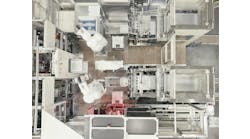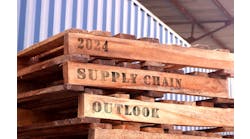The session, sponsored by Rockwell Automation, brought together a well-rounded representation of integrated packaging OEMs for some serious dialogue regarding globalization and new trends in packaging machinery, machine design challenges, robotic control technology, and OEM relationships with end users.
Rockwell’s Mike Wagner of the OEM business unit team led the panel and began by saying that more than 700 original equipment manufacturers based in the U.S. now are involved in some way with supplying packaging machines and services to businesses in Mexico, China and other Pacific Rim nations. “For machine builders and their partners, the manufacturing marketplace is changing the way the industry meets customer demands,” he said. “Regardless of global geography or vertical industry, every OEM is under constant competitive pressure to meet the universal manufacturing demand for high quality, value and performance.”
Globalization and the Packaging Industry
Darren Elliott, chief engineer at R.A. Jones & Co., began the exchange among OEM panelists by addressing globalization issues that affect the industry. He believes a comprehensive set of international standards is necessary for U.S. manufacturers to compete successfully on a worldwide scale.
“The movement of equipment globally forces us to take into consideration design continuity as never before,” Elliot said. “Standards are needed and should be driven by all things working together to make the most cost-effective, value-added machines available.” As a result, Elliott believes OEMs and their partners will be better positioned to handle a market evolution that includes globalization and new international standards.
While at R.A. Jones, Elliott developed a controls standardization program, co-chairs the Jones Safety Committee, and has led several continuous kaizen improvement projects. He points out that OEMs today are being relied upon more to be the packaging experts when it comes to driving consistency in the automated production of goods. Elliott suggests OEMs streamline communication channels to accomplish this goal.
Laurence Oldacre of ATS says there's pressure to build machines affordable to low-cost regions.
“Data management is the next threshold of efficiency,” he said. “Better partnerships need to be formed between the customers, automation suppliers and IT people at the plants. The goal is to maximize efficiency by using better data to drive quality.”
Laurence Oldacre, manager of business development for ATS Automation Tooling Systems, agrees that standardization is important, but notes there’s still a bit of a gulf between what’s acceptable to individual companies and the overall industry.
“The challenge is to find a balance between suppliers, OEMs and end users across the industry as a whole,” said Oldacre, who is responsible for assessing new market opportunities for ATS and managing its strategic partnerships. “There’s considerable pressure for OEMs to build machines that not only are productive, but affordable to low-cost regions.”
OEM and End User Relationships
The struggle of low-initial cost versus long-term value was addressed by Nick DiFabio, lead project engineer at Bradman Lake Group. DiFabio is part of a team responsible for developing standardized machine controls at Bradman and has lead many successful packaging system installations and continuous improvement projects.
DiFabio notes that today’s OEMs need to differentiate the way machines are built for the global community. “Production lifecycles are shorter, with end users manufacturing X today, and Y and Z tomorrow,” he said. “You need to define value beyond cost by building machines with different levels of automation and complexity, as well as for different support, cost and compliance requirements. You have to standardize across the board to service machines globally, and you need to put tech support people on the ground.”
Another trend in the manufacture of low-cost packaging equipment that provides long-term value is the use of integrated robotic technology, which allows you to create standard platforms, DiFabio said. “Robots continually come down in price and go up in reliability and control, which allows end users to run automated production lines at high speed and with less manual labor.”
“Automation must keep up with production,” chimed Peter Fox of Delkor Systems. “As production speeds increase, global companies are unable to place enough workers on the line to handle output,” he said. Fox explained that because machines are often being transferred between companies as production needs change, global specifications for automation levels compatible with more advanced countries need to be established.
“Standards and data management should lead toward better quality and lean manufacturing,” Fox said. “If I were a customer, I’d focus on reliability, performance and uptime instead of brands. You need to provide a platform that gives value add-both upstream and down.”




